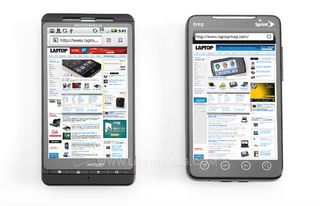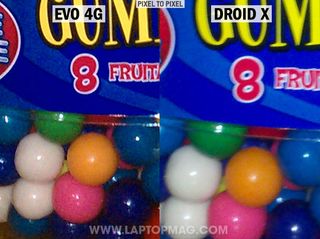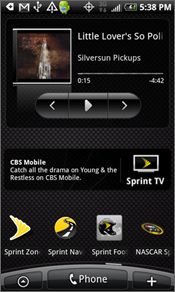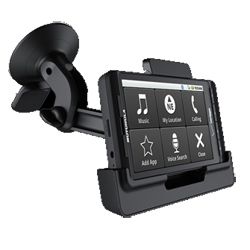Motorola Droid X vs. HTC Evo 4G

For Android fans, this is as big as it gets, and we mean that literally. With huge 4.3-inch displays, the Motorola Droid X and HTC Evo 4G are currently the two biggest Android smart phones on the market. Both of these beasts sport 1-GHz processors, 8-megapixel cameras, 720p video recording, and HDMI output, as well as mobile hotspot functionality. Still, they’re hardly clones. Only the Sprint-exclusive Evo 4G can connect at 4G speeds (36 cities and counting), and it has a front-facing camera for video calls. Meanwhile, the Droid X rides on Verizon’s stellar 3G network, and it has cool features such as Blockbuster video downloads and an NFL mobile app.
So which superphone should be crowned the heavyweight Android champ? Read on—and don’t forget to tell us which device you think is best.
Design
Both the Droid X and Evo 4G are imposing phones—some might say unwieldy—because of their large 4.3-inch screens. However, these slabs are far from identical. The Droid X is lighter than the Evo 4G (5.5 versus 6 ounces), but Motorola’s flagship phone is taller and slightly thinner (5 x 2.6 x 0.4 versus 4.8 x 2.6 x 0.5 inches). Regardless, you’ll definitely know when either of these devices is in your pocket.
While the Evo 4G’s extra heft may cause some to think twice, HTC’s phone has a more premium look and feel with its black glossy front and unique integrated kickstand. We like that the dark gray back of the Droid X has a soft-touch finish, but you’ll either love or hate the bump towards the top of the phone (which houses the camera and dual LED flash). Both HTC and Motorola wisely placed the volume controls on the right side so users don’t have to reach around the device, but we like that the Evo 4G’s rocker is larger.

The Droid X (pictured bottom left) and Evo 4G (pictured bottom right) each have four buttons beneath the display (Home, Menu, Back, Search). However, they’re not in the same order and are implemented differently. The Evo 4G has larger capacitive buttons, while Motorola went with smaller physical buttons. We prefer physical buttons, so we give the Droid X the edge here. Plus, we like that the Home button is the second from the left so you don’t have to stretch your thumb to reach it. (On the Evo 4G it's on the far left.) The Droid X also scores points for having a power button that’s less recessed than the Evo 4G.

Winner: Draw. Although the Evo 4G’s design is more elegant and sports a kickstand, the Droid X’s lighter weight and physical menu buttons make it equally as compelling.
Stay in the know with Laptop Mag
Get our in-depth reviews, helpful tips, great deals, and the biggest news stories delivered to your inbox.
Display
When you have such a large 4.3-inch canvas, screen quality is important, and both the Droid X and Evo 4G impress in their own way. The Droid X is superior when it comes to crispness because it has a slightly higher resolution of 854 x 400 pixels, compared to 800 x 400 for the Evo 4G. We also found that webpages looked brighter.
On the other hand, the Evo 4G brought out details the Droid X missed when we played the Tron: Legacy trailer on both phones side by side (like clouds in the skyline). Overall, the Droid X’s screen has a slightly green cast, while the Evo 4G has a tinge of blue.

Winner: Droid X. This round goes to the Droid X for its higher pixel count. The display is just a little bit crisper, and its whites are whiter.
Software and User Interface
Since both phones run Android 2.1 (with an 2.2 update promised soon), this round is about HTC's Sense vs. Motorola's customized interface for the Droid X. Both have their strengths, but Sense is the more elegant of the two. One example: Leap. From the main home screen (there are seven) you can make a pinch gesture or press the Home button to view thumbnails of them collectively.
The huge clock and weather update on the main Sense home screen is another nice touch (below right). Tapping the former launches the desk clock app, where you can easily set your alarm. The latter option shows you the five-day forecast, complete with nifty animations.

HTC's collection of widgets includes Favorites (contacts), a convenient calendar that shows the month at a glance, a music player widget, and browser bookmarks. You can easily add more widgets from HTC or Android with a couple taps.
The star of the show is FriendStream, which aggregates social updates from Facebook, Flickr, and Twitter. Clicking on a Twitter update, for example, launches HTC's own Twitter client (Peep), where you can reply and retweet. HTC also revamped the stock Android contacts with its People app, which links contacts to their social networking profiles.
The Droid X’s interface is all about flexibility. Like the Evo 4G you can delete widgets and move them around, but you can also resize them as you see fit. For example, if you want to see more upcoming appointments at once, just tap and hold the calendar widget, then drag one of the corners so it takes up more of the screen. You get seven home screens in all, just like the Evo 4G.
Similar to the Evo 4G, you'll find all sorts of widgets, including ones for social networking updates, news, tips and tricks, a photo slideshow, weather, and media player. The interface, though, just feels cruder and somewhat disjointed compared to HTC Sense. Plus, because this is not a Motoblur phone, you can't back up your data to the cloud or find a lost phone as you can with, say, the Motorola Devour. (Verizon includes its own Backup Assistant, though.)
Winner: Evo 4G. The elegant Sense just feels more polished.
Keyboard
Android phones have traditionally trailed the iPhone by a mile when it comes to touchscreen typing, but both the Droid X and Evo 4G are arguably better than Apple's device. With 4.3-inch displays, there's just more room for larger layouts, which means you get bigger keys and a more comfortable typing experience. Motorola's multitouch keyboard on the Droid X is fast and accurate, especially in landscape mode. We also like that if you make a mistake or want to move the cursor to a specific spot, you can press and hold a block of text to magnify it, just as you can on the iPhone. The Evo 4G doesn't have this feature, though you can magnify text for cutting and pasting (say, on a webpage).

Then again, the Evo 4G is no slouch. We typed just as quickly and accurately on this phone. We also appreciate that only this device has special characters above the letters (like above the F) that you can insert just by pressing and holding the letter. The Evo 4G's shorter design actually made typing a little more comfortable than the taller Droid X—we didn't have to stretch our thumbs as much to reach the center of the keyboard—and its slightly wider body made typing in landscape mode less cramped.
Winner: Evo 4G. Both keyboards are great, but we give a slight edge to the Evo 4G because its physical design makes typing more pleasurable in both portrait and landscape mode.
Specs and Performance
Just because the Droid X and Evo 4G both have 1-GHz processors doesn’t mean they’re created equal. The Droid X CPU is a chip from Texas Instruments, the TI OMAP3630, while the Evo 4G packs a Qualcomm Snapdragon processor. Using four Android benchmarks, the Droid X scored higher in every test with the exception of one (Float within Nbench).
| Row 0 - Cell 0 | Row 0 - Cell 1 | Row 0 - Cell 2 | Nbench | Benchmark | |||||
| Row 1 - Cell 0 | FPS2D | LinPack for Android | Memory | Integer | Float | Graphics | CPU | Memory | Filesystem |
| DroidX | 58 | 8.2 | 2.9 | 4 | 0.8 | 31.5 | 777.9 | 424.3 | 162.2 |
| Evo 4G | 30 | 6.7 | 2.5 | 3.8 | 0.8 | 27.8 | 649.7 | 312.9 | 42.4 |
Everyday use, however, was a different story. Whether we were unlocking the phone, swiping between screens, or launching the camera, the Evo 4G was faster (though it stalled at times, too). Our guess is that this performance edge is due to HTC’s more streamlined software. Motorola’s skin and widgets seems to take up more resources.
In terms of memory, the Evo 4G ships with an 8GB microSD Card and supports up to 32GB. The Droid X has 8GB of onboard storage and comes with a 16GB microSD Card, but it can support up to 40GB total.
Winner: Draw. On paper the Droid X is much faster, but the Evo 4G felt snappier during use. We anticipate that the Droid X will live up to its beefier specs once Motorola updates the software.
Web Browsing
When you consider that the Evo 4G offers 4G data and the Droid X doesn't, you might think this round might not even be worth fighting. But the bottom line is that Sprint's 4G network simply isn't widespread, making 3G performance more important for the vast majority of the country (at least for now).
When we tested both phones side by side over 3G—both in our New York City office and on a moving bus along the New Jersey Turnpike—the Droid X loaded pages faster nearly every single time. See the table below for overall averages.
Web Browsing Load Times Over 3G (seconds)
| Row 0 - Cell 0 | NYTimes.com | ESPN.com | CNN.com | Laptopmag.com |
| Droid X | 6.5 | 6.5 | 6 | 14.5 |
| Evo4G | 12 | 7.5 | 8 | 25 |
The Evo 4G’s big advantage is that it connects to Sprint’s growing 4G network, which we tested in Chicago during our initial review. Using the Speedtest.net app, we recorded download speeds ranging from 3.8 to 4.3 Mbps, and uploads ranging from 988 Kbps to 1.1 Mbps. Compare those numbers to Sprint’s 3G network on this phone in the same location, which averaged 917.5 Kbps on the downlink and 435 Kbps on the uplink. So the Evo 4G is about 4.5 times faster when you’re in a 4G area. In real-world terms, the Evo 4G loaded the mobile version of the New York Times website in just 3 seconds, versus 11 seconds over 3G. We also uploaded a photo to Flickr using the 8-MP camera. Over 4G it took 50 seconds, and over 3G the time increased to 1:20.
Web pages look better on the Droid X because of its slightly sharper display, and we give the phone extra points for making it easy to bookmark sites with one tap right next to the address bar, compared to two taps on the Evo 4G.
Winner: Draw. The Droid X offered better 3G data speeds in our tests, but over time Sprint’s growing 4G network will make the Evo 4G a web browsing powerhouse in more places.
Mobile Hotspot Apps
You don’t need to buy a data card for your laptop or a MiFi if you pick up one of these phones. Both the Droid X and Evo 4G have built-in hotspot apps that turn the devices into wireless routers. The service for Verizon’s phone costs $20 per month, and it costs $30 for Sprint’s device. The Droid X supports five Wi-Fi devices at once, while the Evo 4G maxes out at eight. In addition, only the Evo 4G can connect at 4G speeds (where service is available). So this round is a no-brainer, right? Wrong.

In head-to-head tests over 3G, the Droid X averaged 1.1-Mbps downloads when we connected our ThinkPad to the phone in hotspot mode. Uploads averaged a modest 210 Kbps. The Evo 4G in the same locations averaged only 660 Kbps on the downlink but slightly faster 252 Kbps upload speeds. However—and this is big—while commuting back and forth from New York to New Jersey, the Evo 4G did a much better job of holding onto a 3G signal than the Droid X. Often when the signal on the Droid X would drop back to Verizon’s slower 1XRTT network, it wouldn’t switch back to 3G without us restarting the hotspot app. (We think this is a bug of some kind.)
Winner: Evo 4G. The faster 3G speeds offered by the Droid X are cancelled out by the Evo 4G’s even faster 4G capability (where available) and more consistent performance while in a moving vehicle. Add in support for three more devices at any given time, and this round goes to Sprint’s phone—assuming you’re willing to pay $10 extra per month.
Camera and Camcorder
The results speak for themselves. As you can see from the photos we shot, overall the 8-MP camera on the Droid X captured more detailed photos both indoors and out. A photo of the flowery outfit draped on a fashion mannequin positioned on Broadway looked somewhat blown out by the sunlight on the Evo 4G, while Motorola’s phone did a better job capturing a wide range of color.

Indoors, however, the shot we took of a gumball container looked sharper on the Evo 4G because of its faster shutter speed, while Droid X’s image looked sofer. That's what we like most about the Evo 4G: it captures photos more quickly.




The Droid X widened its lead in the video department. The footage we shot outdoors on the Evo 4G looked a bit jerky when we output the footage to a 32-inch Samsung TV via HDMI. We even saw some pixel tearing. The same video shot by the Droid X was more crisp and smooth—more like a camcorder. Its sound was also better.
Winner: Droid X. Despite slower shutter speeds, the Droid X took sharper photos in most conditions, and its 720p videos crushed the Evo 4G's.

Music and Video
Both phones let you download MP3s straight from Amazon. Getting our existing tunes onto the Droid X and Evo 4G was a simple drag-and-drop affair, but Verizon goes the extra mile by including its V CAST Media Manager software for transferring music as well as video (for those who like a little hand-holding). We also prefer the music player interface on the Droid X, which gives a Cover Flow-like treatment to the albums in your collection. The Evo 4G’s music player is more list-like, and the UI doesn’t even support landscape mode. On the plus side, the Evo 4G’s speaker volume was louder, and the sound was richer.
The Droid X starts to pull away when it comes to premium video because Verizon bundles its phone with the Blockbuster app (pictured) for downloading movies. During our initial review video quality was superb. We also like that the Droid X could easily play a 720p Avatar trailer (QuickTime) we transferred to the device. The Evo 4G’s video player couldn’t locate the file, and even when we downloaded a third-party video player (RockPlayer), the video played but the audio didn’t.
Winner: Droid X. A better music interface combined with a BlockBuster app make this smart phone the more robust PMP. However, the Evo 4G deserves credit for its louder speaker volume.

Included Apps/Services
The Blocbuster app (pictured) is a pretty big deal, but the Droid X has a few other cool and useful bundled apps. You get NFL Mobile for staying on top of your favorite team, V CAST Video, the game EA Need for Speed Shift, and Skype Mobile. The Evo 4G comes out swinging in this round with Sprint TV and Qik (for video chat), plus Sprint Navigation (which has a friendlier UI than Google Maps) and Sprint Football Live.
Winner: Draw. We like that Verizon included a high-quality game, but at the end of the day the coolest stuff is in the Android Market.
Special Features
What really makes the Evo 4G unique is its 4G capability, which we discussed in the web browsing section. The speed increase is dramatic; Sprint just needs to accelerate its rollout so more people can make the most of this phone. But one other thing HTC’s phone has that Verizon’s does not is a front-facing camera for making face-to-face video calls. During our initial review the video quality of Qik paled in comparison to the iPhone 4’s FaceTime feature, but at least you can make calls over 3G. And you’re not limited to providers as you are on the iPhone. Fring is another option, though it no longer supports Skype.
The Droid X stands out by offering DLNA capability, which allows users to stream media content over Wi-Fi to other devices that support the standard, from TVs and PCs to Blu-ray players. The feature is pretty easy to set up, but our ThinkPad on the same 802.11n network took a while to load the phone’s pictures. Both the Droid X and Evo 4G will soon be upgraded to Android 2.2, which will bring a performance boost along with Flash 10.1 support.
Winner: Evo 4G. Fast 4G speeds plus a front-facing camera help HTC and Sprint take this round.
Battery Life
One of the biggest complaints people have about the Evo 4G is its relatively short endurance. And we have proof that it’s an issue. On our LAPTOP Smart Phone Battery Test, in which each phone surfs popular web sites at 30-second intervals, the Droid X lasted a very good 6 hours and 56 minutes. The Evo 4G lasted just under 4.5 hours. That’s a huge difference when you’re going to be using your smart phone for everything from web surfing and GPS navigation to watching video.
Winner: Droid X. Although you can tweak plenty of settings to get the Evo 4G to last longer on a charge, Motorola’s phone can go a lot longer away from an outlet without having to lift a finger.
Call Quality
To test the call quality of both phones we left a few voicemail messages on a landline. The Evo 4G on Sprint’s network fared quite well, with our voice coming through loud and clear despite a bit of background noise. The Droid X did a better job of blocking out the surrounding racket, thanks to the three mics it uses for noise cancellation. Otherwise, our message sounded just as clear. On our end, the Evo 4G was a bit louder than the Droid X, but not by much.
Winner: Draw. Both phones are pretty solid in this category.

Accessories
No, neither of these phones can touch the iPhone 4 when it comes to add-ons, but there’s plenty of accessories available for each device. For the Droid X you’ll find a vehicle mount (pictured, $39.99) that includes a dashboard app, a simpler vent and dash mount ($19.99), and a multimedia cradle ($49.99). There’s also a wide selection of cases and chargers, and an HDMI cable ($24.99).
Sprint doesn’t yet sell a vehicle mount (bummer), but it offers a bunch of other accessories. These options include an HDMI cable ($29.99), HTC Silicone Gels to protect your investment ($14.99), as well as several other cases and chargers.
Winner: Droid X. Motorola’s phone wins this round because of its media dock and vehicle mount options.
Pricing and Value
Let’s say you want only 450 voice minutes (no one talks these days, anyway), a data plan, and unlimited texting. With the Droid X you’re looking at $90 per month. For the Evo 4G, the same bundle will cost $80, and Sprint TV/Radio and Navigation is included. However, if you decide to spring for the mobile hotspot service ($20 on Verizon and $30 on Sprint), you’ll wind up paying $110 per month for either device. Add in V CAST for the Droid X and you’re talking $120.
Winner: Draw. If you don’t splurge for the mobile hotspot service the Evo 4G is the better deal, but when you add that perk it’s pretty much a wash.
Overall Winner

Just to be clear, we’re big fans of both the Droid X and Evo 4G, which is why we gave them each an Editors' Choice Award. When you look at the scorecard for this face-off, however, the Droid X wins (barely). It notched an overall score of 11 to the Evo 4G’s 10. Both devices tied in a number of categories, including design, web browsing, specs and performance, included apps, and pricing and value.
Where the Droid X really shined was its crisper and brighter display, faster 3G data performance, better camera and camcorder, and longer battery life. The Evo 4G’s biggest selling points are its 4G capability, more elegant and intuitive interface, and front-facing camera for video chats. For smart phone shoppers, it comes down to what features you care about most--but the point of this journey is to pick a winner. So...
If Sprint’s 4G network were more widespread, this battle might have gone the other way, despite the Evo 4G’s shorter endurance. However, right now the Droid X is the better of the two devices.
| Phone | Droid X | HTC Evo 4G |
| Design | Draw | Draw |
| Display | Winner | Row 2 - Cell 2 |
| Software & Interface | Row 3 - Cell 1 | Winner |
| Keyboard | Row 4 - Cell 1 | Winner |
| Specs & Performance | Draw | Draw |
| Web Browsing | Draw | Draw |
| Mobile Hotspot Apps | Row 7 - Cell 1 | Winner |
| Camera & Camcorder | Winner | Row 8 - Cell 2 |
| Music & Video | Winner | Row 9 - Cell 2 |
| Included Apps/Services | Draw | Draw |
| Special Features | Row 11 - Cell 1 | Winner |
| Battery Life | Winner | Row 12 - Cell 2 |
| Call Quality | Draw | Draw |
| Accessories | Winner | Row 14 - Cell 2 |
| Pricing and Value | Draw | Draw |
| Overall Score | 11 | 10 |
